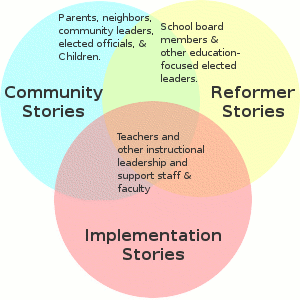There has been an impressive continuing discussion on the New Stories topic among people whom I respect a great deal. Lots of stories have been suggested that range pretty widely across a number of qualities. I thought I would suggest some classification of new story types, so that we can begin to talk about stories within the context of similar plots and functions.
 I am describing three types of stories: Community, Reformer, and Implementation stories. They differ in their length, intended audience, and goal. There is also a fourth type of story that has been suggested, which I am not including at this point. These are the stories that teachers tell their students, as a context builder for specific learning objectives. This may, in deed, be the place to include these stories, but I’ll wait for your opinions.
I am describing three types of stories: Community, Reformer, and Implementation stories. They differ in their length, intended audience, and goal. There is also a fourth type of story that has been suggested, which I am not including at this point. These are the stories that teachers tell their students, as a context builder for specific learning objectives. This may, in deed, be the place to include these stories, but I’ll wait for your opinions.
So here is the breakdown. I will also be including this structure in the New Story Wiki Page (http://newstory.davidwarlick.com/).
Type I — Community Stories
- Audience:
- Non-educator community members, including parents, community leaders (and voters), legislators, etc.
- Story Characteristics:
- This story usually addresses some changing characteristic of the market place and deeply held values (our children), either expressly stated or implied. The story is short and it usually comprises two parts:
- A one sentence statement designed to surprise the listener and usually beginning with something like “Did you know that…”.
- The story sentence is followed by a stated or implied moral or conclusion leading to an intended paradigm shift in thought about education.
- Example:
- Did you know that McDonalds puts pictures on their cash registers, not because kids do not have basic math skills, but because the average McDonalds restaurant services more than 1,500 transactions a day? Success has less to do with the basic skills of making change, and much more to do with adapting to new information environments.
- Goal:
- This level of new story is designed to affect a community’s vision of what education is, and the evolving roles of teachers, learners, and their classrooms.
Type II — Reformer Stories
- Audience:
- Educator leaders who influence local, state, national, or international visioning and structuring of education.
- Story Characteristics:
- These stories are usually longer than community stories, but they also address the market place and deeply held community values (our children). They usually point to an obvious, yet not intuitive flaw in the prevailing structure and curriculum of education and result in a comparison between how it’s done now, and how it might/should be done.
- Example:
- Because information behaves in these ways today, we should stop defining literacy like…, and start defining it like…
- Goal:
- Reformer stories are designed to affect how educators with influence shape their visions, their messages, and their decisions with regard to retooling education within new environments and conditions.
Type III — Implementation Stories
- Audience:
- Classroom teachers and other instructional support professionals
- Story Characteristics:
- This is a longer story, which makes an explicit (or sometimes implied) statement about the nature of learning, teaching, and learning spaces. It points to examples that can be modeled and also points to changes in the market, and deeply held values (our children).
- Example:
- The world is flat because of…. Our classrooms are flat because of… If we can no longer rely on the gravity inherent in hierarchical teaching, then here are ways that we can harness the energies of curious and communicative children to craft learning engines.
- Goal:
- Help educators to value and implement risky but well conceived new teaching and learning strategies, that tie to the changing market place, the evolving information environment, and children who, because of these changes are wired differently as learners.

Excellent points. I do think that there are stories that teachers tell their students. If these stories are simplistic and easy to understand, then they could also be used to teach anyone about the story. When we teach children, we learn how to teach ourselves.
Your post Made me think and I wrote about it tonight.:
http://coolcatteacher.blogspot.com/2006/04/tell-story-simply.html
Thank you for being one of my main inspirations. I hope you’ll be speaking at GAETC in November this year!
Wondering if another circle of Vision or Shared Vision should wrap these three story types?
Thank you David for your work on telling the new story. You’ve inspired me to find these stories and tell them. I just working on a series of Type III stories with 3 teachers from primary, middle and high school environments. I hope you have time to listen to them.
I see they are already included on your wiki. I’m looking forward to more of these stories. I also will be presenting one of them as a video which I think is important in finding new ways to tell new stories.